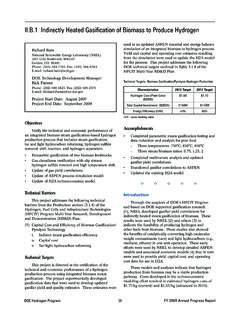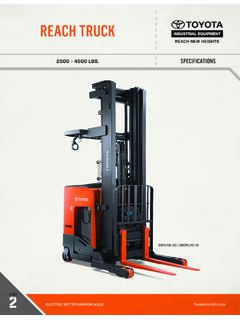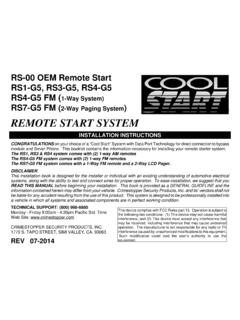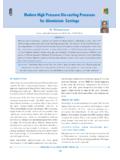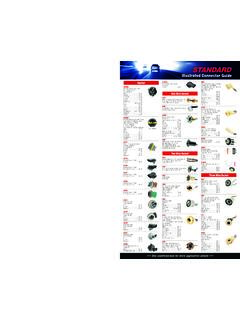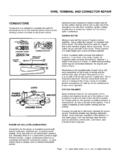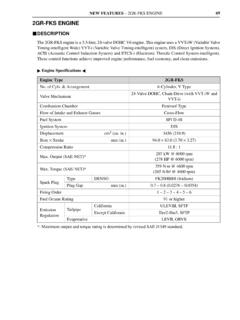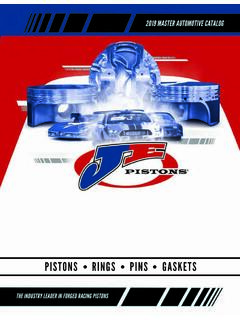Transcription of 2020 DOE Hydrogen and Fuel Cells Program Review …
1 2020 DOE Hydrogen and fuel Cells Program Review PresentationFuel Cell Systems AnalysisPI: Brian D. JamesStrategic Analysis 30, 2020 This presentation does not contain any proprietary, confidential, or otherwise restricted ID# FC163 Overview Project Start Date: 9/30/16 Project End Date: 9/30/21 % complete: 70% of five year project (in Year 4 of 5)2 Timeline Total Funding Spent ~$832k (through March 2020, SA only) Total DOE Project Value $ (over 5 years, excluding Labs) 0% Cost shareBudget B: System cost Realistic, process-based system costs Need for realistic values for current and future cost targets Demonstrates impact of technical targets & barriers on system cost: Balance of plant components Materials of construction System size and capacity (weight and volume)Barriers National Renewable Energy Laboratory (NREL) Argonne National Lab (ANL)PartnersRelevance Project current (2020)and future cost (2025) of automotive, bus, & truck fuel cell systems at high manufacturing rates.
2 Project impact of technology improvementson system cost Identify low cost pathwaysto achieve the DOE target values Benchmarkagainst production vehicle power systems Identify fuel cell system cost driversto facilitate fuel Cell Technologies Office programmatic decisions. Quantify the cost impact of components that improve Project Objectives: Current TargetsUnits(2016$)Project StatusDOE 2020 TargetDOE Ultimate Target20202025 Cost of LDV FC Power Systems a, b$/kWnet46394030 Cost of LDV FC Stacks a, b$/kWnet19122015 Cost of LDV Bipolar Plates a$/kWnet6b / 3c4b3 NAAir Compression System Cost a$/system760710500 NACathode Humidifier System Cost a$/system6262100 NACost of HDV FC Power Systems a, c$/kWnet847180 (2030)60aBased on high production volume (500,000 LDVs per year and 100,000 HDVsper year)b Based on stamped SS316 bipolar plates for LDVc Based on embossed flexible graphite bipolar platesRelevance: Timeline of Analyses4 YearProject YearTechnologyProposed Analyses2017180kW LightDuty Vehicle (LDV)Current (2017), 2020, 2025 Med/HeavyDuty TruckScoping StudyLDV System or Stack ComponentValidation Study 2018280kW LDVC urrent (2018), 2020, 2025160kW MDV Class 6 TruckCurrent (2018), 2020, 202520193330kW HDV Class 8 TruckCurrent (2019), 2025170kW MDV Class 6 Truck Current (2019), 20252020480kW LDV*Current (2020), 2025275kW HDV Class8 Truck Current (2020), 2025170kW MDV Class 6 Truck / Class 8 Bus Current (2020), 202520215 LDVC urrent (2021), 2025 Update to Buses & Trucks as neededCurrent (2021), 2025*As recommended by DOE, the LDV cases are limited to modest updates ( less detailed analysis than previous years of the LDV analysis).
3 Incorporating ANL performance modeling of heat rejection and catalyst performance for 2020 HDV lead to $12/kW reduction in system cost Addition of cost for stack and system components that improve durabilityImpact since 2019 analysis final results: Topics Examined Since 2019 AMR5 Annually apply new technological advances and design of transportation systems into techno-economic models Approach:2020/2025 Light Duty Automobile Systems Updated Air Filtration System: Augmentation of air loop components and updated pricing provided by Mann + Hummel (In Process) Impact of Durability on Cost: Assessment of system operation mitigation techniques (Ongoing Analysis)2020/2025 Medium Duty/Bus and Heavy Duty Truck Systems Updated Operating Conditions:Collaboration with ANL and FCPAD (Interim Results) Updated Air Filtration System (same as above) Hybridization Study: Modeling of FC system sizing and optimal operation for durability(Interim Results) Total Cost of Ownership (Class 8 Long-Haul System)2019/2020 Side Studies for Automotive/MDV/HDV System (not affecting baseline) Ionomer Manufacturing Study: Evaluation of gas-phase and continuous liquid epoxidation of hexafluoropropylene(HFP) (Preliminary Analysis)Milestone 1: Validation Study Completed in 2017 Milestone 2,5,8,11: System Definition Completed for 2020/2025 LDV, MDV and HDV SystemsMilestone 3,6,9,12: DFMA Cost Analysis Completed for 2020/2025 LDV, MDV and HDV SystemsMilestone 4,7,10,13: Reporting of Cost Results (due Sept 2020) => Go/No-Go DecisionAccomplishments and Progress:Preliminary Cost Results for 2020 Systems6 Cost differences between LDV and MDV/HDV at 100k sys/year due to: Total Pt loading ( LDV vs MDV/HDV) LDV system considered as a vertically integrated OEM vs.
4 MDV/HDV systems assume a non-vertical integration Applied extra markup for MDV/HDV FC developer and power system integrator Additional vendor/job-shop assumptions in non-vertically integrated systemsAccomplishments and Progress:Class 8 Long-Haul HDV System Performance Modeling Shows Capital Cost-and Durability-Optimal Operating Conditions ($84/kW at at 88 C) 7 ANL modeling of radiator heat rejection at various FC stack conditions shows limitation of heat transfer Power density has larger impact on cost than radiator sizing2019 HDV System (330kWnet)2020 HDV System (275kWnet)Gross Power (kWgross)415346 Power Density (mW/cm2)8401,050 Total Pt loading (mgPt/cm2 total area) (cell voltage)400V ( )400V ( )Stack Temp. (Coolant Exit Temp) ( C)85 (peak temp. during6% grade)88 (peak temp. during6% grade)Q/ T (kWth/ C) (Tambient=25 C) Cost ($/kWnet)$97$84 Lowest Cost CasesLower temperature is better for durability Cell VoltageAt lower voltage, limited to higher operating tempIncreasing cell voltage => smaller radiatorCurrent system does not include external humidification to limit Pt dissolutionQuantifying the Impact of Durability on Cost Review of areas where durability issues could impact the system cost Collaborated with NREL, ANL, and LANL to create list of mitigation steps List broken into two categories: Materials and System Solutions8 Mitigation StepHardwareOther ImpactsCurrently in Models?
5 Current StatusMaterial Solutions(to improvestack durability)Increase Pt loadingIncrease total Pt loading to power densityLDV: NoMD/HDV: YesCollab. With ANLUse radical scavengersAdd 9 micrograms Ce/cm2(in form of CeO2nanopowder) to cathode catalyst inkLDV: To be addedMDV/HDV: YesEasy and inexpensive to addManage particle agglomeration Novel catalyst geometries and formulationsProbable increase in synthesis costs. Potential water management currently modeledR&D neededLimit leachingMiraiapproach: use <10%mol Co (in cathode catalyst)LDV: NoMDV/HDV: YesNot applied to baseline LDVB ipolarPlate Base MaterialLDV:Tiplates (used in Mirai)MDV/HDV: GraphitePlatesTimaterial would increase material :NoMD/HDV: YesFlexibleGraphite BPP analyzedOther material solutionsEg. Use of high performance, inherently durable catalysts with high surface area carbon supportsUnknownNoR&D neededAccomplishments and Progress:9 Mitigation StepHardwareOther ImpactsIn Current Model?Current StatusSystem Solutions(to improvestack durability)Thicker membrane to delay failure due to membrane thinning25 micron membrane (instead of <14 micron) Lowers power densityNoANL on 14 mmDummycells on stack ends to prevent condensation1 or 2 dummy Cells on each end of stack.
6 Adds $ to $ temperatureuniformity for all power generating cellsYesToyota and Honda Patents of Anode at shut-downAdd 3-way valve, $24-$50 each, 1 per stackAdditional H2loss during each shutdown. Shutdowns more frequent than current/baseline sys. Partially offset by reduced anode purges (of N2&water buildup)LDV: NoMD/HDV: YesAir-purge questioned. temperature to <90 CLarger radiator: at peak 85 C 18% areaincrease (93 -40 )/(85 +40 )= (slightly) lower power-density and larger-stackLDV: NoMD/HDV: YesANL analysisClip voltage at monitoring systemRegulate air flow,temperature, and humidity to avoid stack operation at high cell voltage while still load-following. In ProcessANL/FCPAD analysis & testing. SA to quantifycostLimit voltage slew rateNo hardware change neededTime delay expected to be ~1 sec. Negligiblebattery size impact neededAccomplishments and Progress:10 Mitigation StepHardwareOther ImpactsIn Current Model?Current StatusSystem Solutions(to improve stack durability)Run drier, lower RH reducesPt dissolutionRemove humidifierLowers power density, restricted operation to prevent membrane : NoHDV: YesANL 2020 Analysis Run wetter/ Run with less RH variabilityPossibly larger Bus approach: run wetter.
7 Approach: avoid RH swings that cause pin-holes at inlet and outletImpacts power densityNoPotential ANL analysisRun load through shut-down and don t let voltage go upAdditional system controls maybe needed: +$100/systemIn ProcessSA to quantify costOversize stackIncrease in stack sizeIncreased stack size would increase cost (<$2/kW for LDV and <$5/kW forHDV at high volume) but also increases fuel : NoMD/HDV: Yes, +10% of active areaSA to analyzeimpact on fuel economyAccept >10% power degradation over system lifetimeNo/limited hardware impactApproach: redefine durability System will provide <90% rated power in later years of lifetimeNoEasy to postulate,but really supplier in battery in fuel processSA to analyzeAccomplishments and Progress: ANL modeling shows 8,000hrs can be achieved with <53% ECSA loss (correlates with 10% power loss, end of life) if durability-optimized operating conditions are maintained (primarily cell voltage < ) SA to continue working with ANL on these activities in the future to estimate the cost impact for systems capable of meeting 8,000hrs without accepting 10% power deratingHybridization Study Motivation and Background Primary motivation.
8 Develop additional strategiesto evaluate the cost impacts of durability Stack cycling, particularly at part power and high voltage, is a significant source of degradation FC-dominant architectures operate at part power for the majority of the drive cycle Alternative hybridization schemes with the stack operating at constant power in an on/off mode can increase the effective life of the stack (by turning FC off during large fractions of vehicle motion) Goal is to study the cost, efficiency, and durability tradeoffsfor alternative hybridization strategies compared to a fuel cell dominant architecture across a number of vehicle applications: LDV, MDV, and HDV11 Accomplishments and Progress: Stack cycles on/off depending on battery SOC and motor controller requirements Simulation is adapted from FASTSim* model (2018 python version)*Brooker, Aaron, Jeffrey Gonder, LijuanWang, Eric Wood, Sean Lopp, and Laurie Ramroth. FASTSim: A Model to Estimate Vehicle Efficiency, Cost and Performance, 2015-01 0973, 2015.
9 Study Results for FCEB on BraunschweigDrive Cycle Bus is idle a significant fraction of the time and the fuel cell sits at or near 0 kW for ~50% of cycle. Minor change in fuel economy over single drive cycle at various stack sizes (Preliminary Results).Accomplishments and Progress:FC dominant system: Load-Following ModeFC Hybrid Systems: On/Off mode12 Preliminary 160kW fuel cell sits at 0 kW for ~80% of cycle. Tight controls on start-up/shut-down are needed to realize fuel cell lifetime gains Future models to incorporate operating conditions to limit ECSA loss and impose fuel economy degradation over vehicle life. 160kW FC140kW FC120kW FC100kW FC80kW FCDistance (miles)FCEB= fuel Cell Electric BusHybridization strategy to also be applied to LDV, MDV, and HDV TruckPFSA Ionomer ProductionIonomer Cost Analysis Two previous reports by GM (Xie, 2010)1 and Roland Berger (Bernhardt, 2013)2analyzed the cost of PFSA production by estimating the CAPEX/OPEX of steps 1-3 and using market price HFPO as input HFPO and PVE synthesis (from HFPO) identified as major cost drivers Recent set of literature suggests that gas-phase epoxidation could produce cheaper HFPO than the liquid-phase epoxidation routes most commonly used(1) Xie, T.
10 ; Mathias, M. F.; Gittleman, C.; Bell, S. L. High Volume Cost Analysis of PerfluorinatedSulfonic Acid Proton Exchange Membranes; fuel Cell Activities; General Motors: Honeoye Falls, NY, 2010.(2) Bernhardt, W.; Riederle, S.; Yoon, M. fuel Cells --A Realistic Alternative for Zero Emission?, and Progress:Gas-Phase HFP EpoxidationFocus on Estimating HFPO Cost SA performed a detailed DFMA analysis of liquid-phase and gas-phase epoxidation At low production rates, liquid-phase HFPO production is cheaper by ~10%. The lower reaction selectivity of the gas-phase approach necessitates higher capital expenditures for separations and waste handling At high production rates, gas-phase synthesis is ~20 30% less expensive due to lower Materialscosts: Cheap oxidant (O2) Inexpensive catalyst/initiator (copper tubes) No liquid solvent(s) 14 Accomplishments and Progress:Gas-vs. Liquid-Phase HFPO Effect on Ionomer Costs The decrease in HFPO costs from gas-phase synthesis at high production rates results in a 6% ( estimate) to 12% ( estimate) decrease in total ionomer costs If gas-phase reaction selectivity can be improved to 90% (without major cost increase), the decrease in ionomer costs would be 10% -19% HFPO is a significant cost input for PFSA ionomers, but one of many factorsManufacturing Cost Estimates comparing HFPO Synthesis Methods6% decrease12% decrease15 Accomplishments and Progress:Ionomer Resin Manufacturing Cost w/ Industry Quotes The Industry PriceQuotes (max.)



